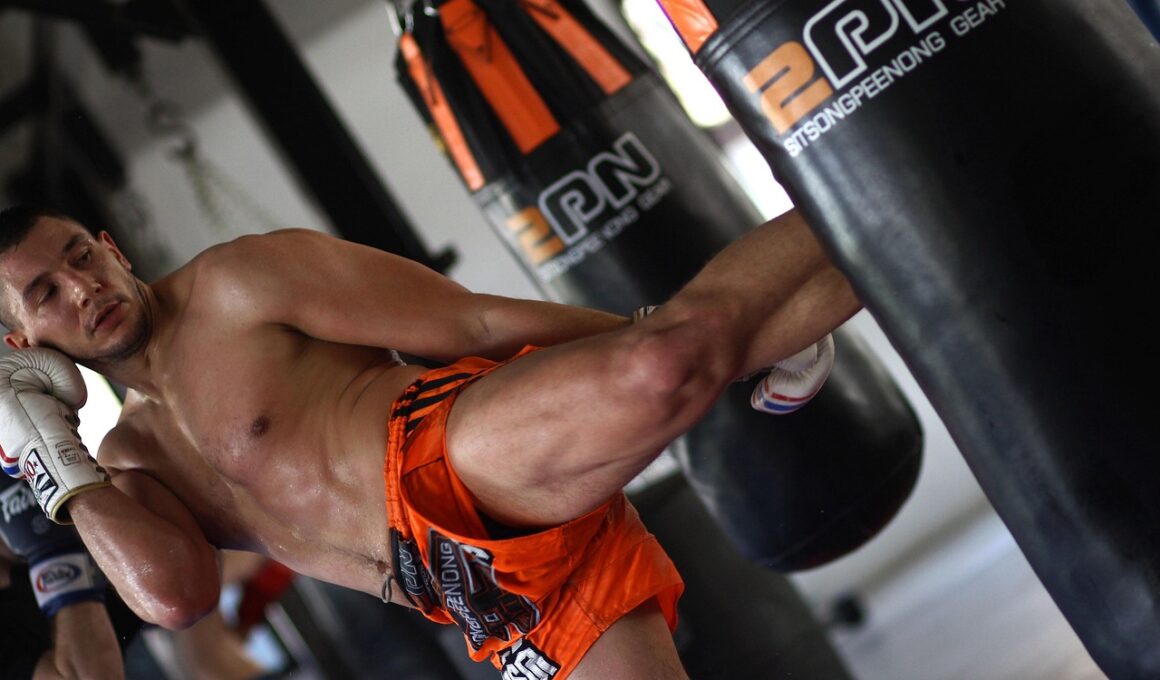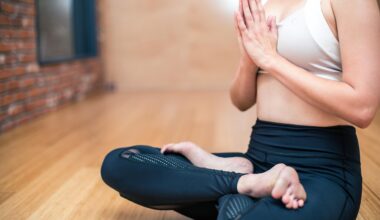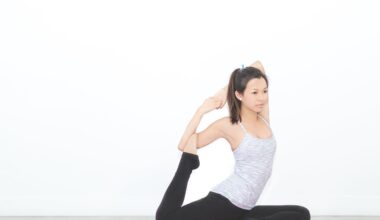Using Partner Drills for Outdoor Martial Arts Conditioning
Outdoor martial arts conditioning is a transformative way to enhance both physical fitness and skill levels. Engaging in partner drills adds a dynamic element to training sessions, promoting teamwork and mutual motivation. With partners, participants can develop a deeper understanding of techniques while also enhancing their cardiovascular endurance and strength. In such drills, multiple exercises can be performed focusing on footwork, striking, and defensive maneuvers. Each partner must stay attuned to the other’s movements, which cultivates a refined sense of timing and rhythm crucial in martial arts. Furthermore, the outdoor environment adds variables that enhance the training experience like wind, uneven terrain, or varying light conditions. This unpredictability prepares martial artists for real-world scenarios where conditions are not always ideal. As partners engage in resistance drills or sparring, they push each other to exceed limits. This competitive spirit elevates the group’s overall training intensity. It’s essential for martial artists to communicate effectively during drills, ensuring that both partners work towards each other’s improvement. The fun aspect of working with a partner also contributes to greater enjoyment and adherence to training regimens, ensuring consistency in outdoor workouts.
Effective outdoor partner drills can be structured to target specific aspects of martial arts conditioning. For instance, incorporating warm-up routines followed by technique drills can optimize performance. A common approach is to start with basic movements, focusing on stance and posture to ensure a solid foundation before adding complexity. Partners can alternate between executing techniques such as punches, kicks, and blocks. Performing these drills repetitively helps build muscle memory, ensuring that techniques are executed fluidly during practice. Additionally, implementing light sparring sets provides a practical application of skills learned in driller format. This is where the benefits of outdoor conditioning significantly shine, as partners can cover longer distances, accelerating cardiovascular fitness. Variability in training conditions can also help boost adaptability and resilience. The interaction between both partners creates an engaging experience, making workouts challenging yet enjoyable. To enhance motivation, setting fitness goals or challenges within the drills can also foster a competitive atmosphere. Partners can time their sprints, count successful strikes, or gauge reaction times. These friendly competitions develop performance metrics, allowing martial artists to keep track of their progress while encouraging continuous learning and improvement during outdoor workouts.
Building Technique through Partner Drills
Partner drills not only focus on strength but also hone technique, which is vital in outdoor martial arts conditioning. Practicing techniques with a partner enables martial artists to gain immediate feedback. Drills such as pad work exemplify this, where one partner holds pads while the other strikes. This setup allows practitioners to learn how to hit accurately while understanding the power they can generate. Correcting each other’s form fosters an environment of constant improvement. Additionally, allowing partners to alternate in roles ensures that both parties benefit equally, providing insight from different perspectives. Furthermore, setting specific drills aimed at different types of strikes—such as hooks, jabs, or uppercuts—ensures a comprehensive skillset. Conditioned hands and feet enhance reaction times, crucial in competitive scenarios. Incorporating movement within the drills can improve agility; this is where being outdoors adds another layer. Adjusting to different surfaces teaches balance and helps strengthen stabilizing muscles concurrently. Engagement in these drills also develops mental fortitude, as practitioners must remain focused and strategic under pressure. Overall, partner drills create a synergistic learning experience that is effective and enjoyable, fostering bonds between practitioners as they strive towards their individual and collective goals.
Beyond building physical prowess, partner drills in outdoor martial arts conditioning can significantly enhance camaraderie. The partner training structure encourages practitioners to rely on each other for motivation, accountability, and constructive critique. This emotional support is important in martial arts, where learning complex movements can sometimes be frustrating. Creating a positive atmosphere where partners share successes and challenges allows for improved resilience. Hosting outdoor training sessions in varied locations keeps routines fresh and encourages exploration of new techniques. Change of scenery can also spark creativity, allowing participants to visualize and apply their learnings in unique contexts. Engaging with nature often leads to feelings of relaxation and a greater appreciation for the practice itself. As individuals sharpen their skills together, they form lasting friendships based on shared experiences and mutual respect. Regularly scheduled outdoor conditioning sessions can create a community among martial artists, fostering a culture of inclusion and support. These relationships extend beyond workouts, encouraging social interactions that benefit overall well-being. Participants might also motivate each other to achieve fitness milestones, forging a bond through shared goals. Such collaborations enhance the overall experience of martial arts training, promoting a holistic approach to physical and mental health.
Creative Partner Drills for Enhanced Engagement
Creativity plays a crucial role in outdoor martial arts conditioning, especially when it comes to partner drills. Practitioners can devise their drills to keep engagements exciting and challenging. Implementing varied scenarios within drills tests adaptability in both partners. This could involve introducing unexpected elements such as varying speeds, angles, or combinations in strikes. Pairing martial arts techniques with functional movements like lunges or sprints not only increases engagement but also targets different muscle groups. For instance, transitioning from a punch to a defensive roll can significantly enhance physical capability. The use of outdoor space can also inspire fitness games, fostering a fun environment for partners. Using objects like cones or ropes to set up obstacle courses can integrate techniques while increasing cardiovascular output. Alternating roles in every set allows both partners to experience being the striker and the defender. This adaptation enhances their understanding of roles in a combat situation while building respect for each other’s respective skills. Ultimately, the primary goal of these drills is not only to improve conditioning but to keep both participants motivated and invested in their martial arts journey while enjoying the beauty of the outdoors.
Safety is paramount during outdoor partner drills in martial arts conditioning. Ensuring that both partners are aware of their surroundings and taking care when executing moves mitigates risks of injury. Clear communication is vital to achieving this safety; partners must express potential hazards they encounter in their training space. Establishing a safe distance during drills plays a significant role in maintaining safety, especially when practicing techniques with significant force. Practicing with controlled intensity allows for accurate representation of power without compromising injuries. Safety gear such as gloves or shin guards can provide an additional layer of protection while sparring. Regular stretches incorporate injury prevention techniques, enhancing flexibility for both participants. This precaution minimizes the chance of strains during any drills. Being mindful of fatigue levels is essential; partners should monitor each other and take necessary breaks. This helps sustain energy levels throughout training sessions. Additionally, focusing on proper technique helps prevent improper form that could lead to injuries. Partners should dedicate time to gradually increase the intensity of their drills to adapt and adjust safely. When practitioners prioritize safety, they create an environment conducive to growth, enabling consistent outdoor martial arts training experiences without unnecessary risks.
Conclusion: Embracing Outdoor Martial Arts Conditioning
In conclusion, embracing outdoor partner drills for martial arts conditioning promotes a versatile and effective training regimen. The dynamic interactions fostered by working with a partner enhance both performance and social connections between practitioners. Through creative and focused drills, martial artists can maximize their conditioning while enjoying the camaraderie that comes with shared learning experiences. The unpredictability of outdoor environments adds an enriching layer to training, requiring adaptability and resilience from all participants. Practitioners can cultivate a variety of skills, from technique to teamwork. As dedication to fitness increases through these sessions, the foundation for a lifetime martial arts journey is established. Ultimately, keeping the focus on enjoyment and safety ensures that outdoor workouts remain a sustainable practice. The unity found in improving with a partner not only accelerates individual growth but builds lasting relationships. For martial artists aiming to enhance their conditioning, engaging in partner drills serves both as an effective training methodology and a means of fostering communal spirit. This unique approach to outdoor physicality can significantly impact the holistic development of practitioners, guiding them through challenges and achievements alike on their martial arts path.


